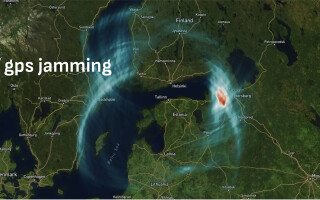The power of light: A shortcut to satellite-based quantum encryption
StoryAugust 11, 2017
Researchers in Germany have demonstrated ground-based measurements of quantum states sent by laser aboard a satellite 38,000 kilometers above Earth, suggesting that satellite-based quantum encryption may be within reach by as soon as five years.
Researchers in Germany have demonstrated ground-based measurements of quantum states sent by laser aboard a satellite 38,000 kilometers above Earth, suggesting that satellite-based quantum encryption may be within reach by as soon as five years.
Quantum entanglement, which Albert Einstein termed “spooky science at a distance,” is the physical phenomenon at the heart of the demonstration by of a team of researchers at Max Planck Institute for the Science of Light that the technology on satellites – already space-proofed against the harsh environments – can be used to achieve quantum-limited measurements. They believe this puts satellite quantum networks within reach much sooner than anticipated and significantly reduces the development time involved.
“We were quite surprised by how well the quantum states survived traveling through the atmospheric turbulence to a ground station,” says Christoph Marquardt, group leader of Quantum Information Processing at the Max Planck Institute for the Science of Light in Germany.
Satellite-based quantum encryption networks could provide an extremely secure way to encrypt data sent over long distances. The researchers estimate that such a system is possible within five years, although that seems extremely fast if you consider that satellites generally require roughly 10 years of development work.
Quantum key distribution encryption, instead of relying on math, taps properties of light particles known as quantum states to encode data and send the decryption key. If anyone attempts to measure the light particles to steal the key, it changes the particles’ behavior in a way that alerts the intended communicating parties that the key has been compromised and should not be trusted. In other words: Eavesdropping will be detected, so secure communication is guaranteed.
“Quantum cryptography ensures long-term security of information,” Marquardt says. “This is especially important for strategic information, but also ensures that you’re safe against unknown threats against current encryption algorithms – apart from the quantum computer threat that will become more urgent during the next decade. And a satellite service could connect different bases or embassies.”
To measure quantum states, the researchers worked with satellite communications company Tesat-Spacecom GmbH and the German Space Administration. The German Space Administration had previously contracted with Tesat-Spacecom on behalf of the German Ministry of Economics and Energy to develop an optical communications technology for satellites. The technology they previously developed is now being commercially used in space for laser communication terminals onboard Copernicus – the European Union’s Earth Observation Program – and by SpaceDataHighway, the European data-relay satellite system.
Marquardt and colleagues discovered that this satellite optical communications technology works much like the quantum key distribution method developed at the Max Planck Institute. So they set out to see if it was possible to measure quantum states encoded within a laser beam sent from a satellite already in space.
During 2015 and the beginning of 2016, the team made these quantum state measurements from a ground-based station at the Teide Observatory in Tenerife, Spain. The team created quantum states within a range where the satellite normally doesn’t operate, which enabled them to make quantum-limited measurements from the ground.
From their measurements, they deduced that “the light traveling down to Earth is very well suited to being operated as a quantum key distribution network,” Marquardt says. “We were surprised because the system wasn’t built for this. The engineers had done an excellent job of optimizing the entire system.”
Now, the researchers are working with Tesat-Spacecom and others within the space industry to design an upgraded system based on hardware already used in space. Marquardt says that while quantum communication satellite networks won’t need to be designed from scratch, converting ground-based systems to quantum-based encryption to communicate quantum states with satellites may still take five to 10 years. This effort will involve upgrading the laser communication design, incorporating a quantum-based random number generator to create random keys, and integrating post-processing of the keys.
The team’s work is generating “serious interest from the space industry and other organizations to implement scientific findings,” Marquardt says. “We, as fundamental scientists, are now working with engineers to create the best system and to ensure no detail is overlooked.”
It’s also worth noting that another significant advance within this realm was very recently made by an unaffiliated team of researchers from the University of Science and Technology of China: They demonstrated satellite-based distribution of entangled photon pairs over a distance of 1,200 kilometers, which they say now “opens the door to both practical quantum communications and fundamental quantum optics experiments at distances previously inaccessible on the ground.”





